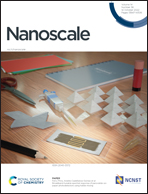Abnormal linear dichroism transition in two-dimensional PdPS†
Abstract
The linear dichroism (LD) conversion shows promising applications for polarized detectors, optical transition and light propagation. However, polarity reversal always occurs at a certain wavelength in LD materials, which can only distinguish two wavelength bands as wavelength-selective photodetectors. In this study, the multi-degree-of-freedom of optical anisotropy based on 2D PdPS flakes is carefully described, in which four critical switching wavelengths are observed. Remarkably, the quadruple LD conversion shows a significant wavelength-dependent behavior, allowing us to pinpoint five wavelength bands, 200–239 nm, 239–259 nm, 259–469 nm, 469–546 nm, and 546–700 nm, for a wavelength-selective approach to photodetectors. In addition, the polarized photoresponse under 532 nm was realized with an anisotropy factor of ∼1.51 and further illustrated the in-plane anisotropy. Raman spectroscopy of PdPS flakes also shows strong phonon anisotropy. The unique wavelength-selective property shows great potential for the miniaturization and integration of photodetectors.



 Please wait while we load your content...
Please wait while we load your content...